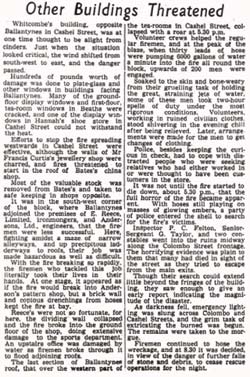Other buildings threatened.
The Star-Sun, Nov 19, 1947. p.4.
Whitcombe's building, opposite Ballantynes in Cashel Street, was at one time thought to be alight from cinders. Just when the situation looked critical, the wind shifted from south-west to east, and the danger passed.
Hundreds of pounds worth of damage was done to plate-glass glass and other windows in buildings facing Ballantynes. Many of the ground floor display windows and first-floor, tea-room windows in Beaths were cracked, and one of the display windows in Hannah's shoe store in Cashel Street could not withstand the heat.
Efforts to stop the fire spreading westwards in Cashel Street were effective, although the walls of Mr Francis Curtis's jewellery shop were charred, and fires threatened to start in the roof of Bates china shop.
Most of the valuable stock was removed from Bates's and taken to safekeeping in shops opposite.
It was in the south-west corner of the block, where Ballanytnes adjoined the premises of E. Reece, Limited, ironmongers, and Andersons, Ltd., engineers, that the firemen were less successful. Here, fighting amidst a maze of narrow alleyways, and up precipitous ladderways to roofs, their job was made hazardous as well as difficult.
With the fire breaking so rapidly, the firemen who tackled this job literally took their lives in their hands. At one stage, it appeared as if the fire would break into Anderson's pattern shop, but a brick wall and copious drenchings from hoses kept the fire at bay.
Reece's were not so fortunate, for here, the dividing wall collapsed and the fire broke into the ground floor of the shop, doing extensive damage to the sports department. An upstairs office was damaged by water as firemen broke through it to flood adjoining roofs.
The last section of Ballantynes roof, that over the western part of the tea-rooms in Cashel Street, collapsed with a roar at. 6.30 p.m.
Volunteer crews helped the regular, firemen, and at the peak of the blaze, when thirty leads of hose were pumping 6000 gallons of water a minute into the fire all round the block, upwards of 200 men were engaged.
Soaked to the skin and bone-weary from their gruelling task of holding the great, straining jets of water, some of these men took two-hour spells of duty under the most rigorous conditions. Volunteers. working in ruined civilian clothes stood shivering in the evening chill after being relieved. Later, arrangements were made for the men to get changes of clothing.
Police, besides, keeping the curious in check, had to cope with distracted people who were seeking relatives who had either worked in or were thought to have been customers in the store.
It was not until the fire started to die down, about 5.30 p.m., that the full horror of the fire became apparent. With hoses still playing on masses of glowing embers, a party of police entered the shell to search for the fire's victims.
Inspector P. C. Felton, Senior Sergeant G. Taylor, and two constables went into the ruins midway along the Colombo Street frontage. The horrifying evidence was plain to them that many had died in sight of the street as they tried to escape from the main exits.
Though their search could extend little beyond the fringes of the building they saw enough to give an early report indicating the magnitude of the disaster.
As darkness fell, emergency lighting was slung across Colombo and Cashel Streets, and the grim task of extricating the burned was begun. The remains were taken to the morgue.
Firemen continued to hose the wreckage, and at 8.30 it was decided, in view of the danger of further falls of stone and debris, to cease rescue operations for the night.


 Discover your family’s history at our libraries
Discover your family’s history at our libraries

